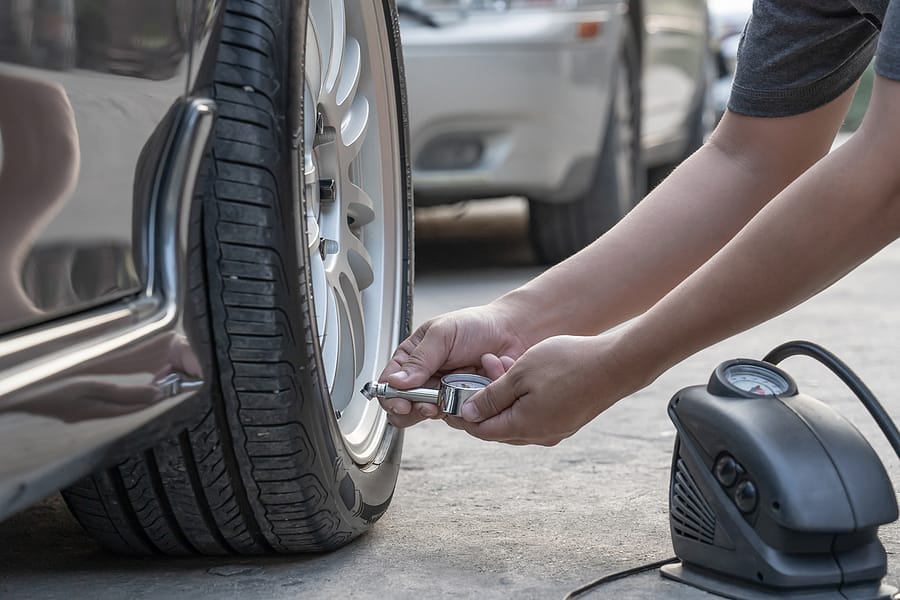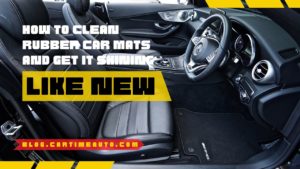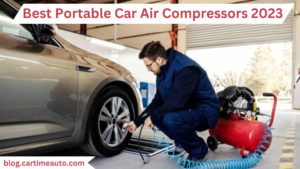Keeping your tires in shape is one of the most important car maintenance tips for safe driving and for keeping your repair and replacement costs down. Why? Damaged, incorrectly inflated, and uneven tires can lead to unstable handling, faster tire wear, and even blowouts.
Understanding how to keep your car tires in good condition means knowing what to look for and how often you should inspect your tires. Here are six car tire care tips for keeping your tires in shape.
Monitor Tire Pressure
One of the easiest tire care tips is to check your tire’s air pressure. Improper inflation can lead to skidding, loss of control, decreased stopping distances, and other dangers. Incorrect tire pressure can also decrease fuel economy and shorten a tire’s lifespan. It’s a good idea to check your tires’ pressure monthly to keep them in shape.
To check your tires’ air pressure, use a tire pressure gauge when the tires are cold for an accurate reading. While most tires have a tire pressure recommendation on the sidewalls, be aware that these are often maximum pressure levels. Check the inside driver’s door jamb or the owner’s manual for the correct car tire maintenance recommendations for your vehicle.
Measure Tire Tread
According to Goodyear, maintaining at least 4/32 inch of tread keeps tires performing safely and efficiently. You can measure your tires’ tread at home. A tire pressure gauge is the most accurate way to check tread depth, but there are other methods that will do in a pinch.
When you check your tire tread depth, skip the outdated penny test and use a quarter instead. The old penny method measured when tread reached 1/16 inches, showing it’s time to replace the tire. But a quarter measures when the tread reaches 1/8 inches, indicating the tire still has sufficient tread for optimal performance.
Align Front Tires
The front tires on your vehicle will need alignment periodically for safety and performance. But this is one car tire maintenance tip that requires specialized equipment, so you’ll need to take your car to a professional. Because misaligned tires can lead to excessive tire wear and rough handling, there are some typical symptoms that let you know you may have an alignment problem:
- Uneven tire wear or tires that are visually not parallel
- A vehicle’s steering wheel pulls to one side with hard braking
- The steering wheel vibrates even on smooth road surfaces
- A vehicle’s steering wheel turns to either side when hands are off the wheel
Rotate Tires
Getting your tires rotated routinely is a tire care tip that extends the life of your tires because it ensures even wear on front and rear tires. Rotating your tires with the right frequency also gives you more balanced handling and better traction, making your vehicle safer. According to Car and Driver, have your tires rotated about every 3000 to 5000 miles, about the same recommended frequency as oil changes.
Match Tires
When we get a flat tire that can’t be repaired, most of us might replace just that tire. It’s important to understand how mismatched tires can affect the safety and performance of your vehicle. Every tire model has a specific size, speed rating, load index, and other criteria that determine how the tires will perform. When you mix models of tires, you can’t rely on the consistent performance and wear that’s so important to how your vehicle handles.
Instead of just replacing a single tire, bite the bullet and buy a pair at least and have them installed on the rear and have the older tires moved to the front. Whether your vehicle has rear-wheel or front-wheel drive, putting new tires on the rear axle provides greater stability and better steering and braking.
Avoid Overloading Tires
Whether you drive a truck or a car, overloading a vehicle can negatively impact handling and could damage your tires. Even if you don’t haul much weight around in your vehicle, it’s a good idea to know the safe load limits. Many cars will have the load limits along with the tire pressure recommendations on the driver’s side door jamb, or you can check your owner’s manual. Besides weight limits, your owner’s manual can also tell you when to inflate and deflate tires for different loads.
Now that you know how to make tires last longer and perform safely, make a habit of performing car tire maintenance on a regular schedule. Keep your tires in shape using these car tire care tips for safer, more enjoyable driving and longer-lasting tires. contact Car Time Supercenter today at (888) 557-4326 to learn more and browse our wide selection of used vehicles.

There are good reasons people will buy their next used car in Tucson from Car Time Supercenter. But I think we are one of the most trusted used car dealerships mainly because we treat everyone like family. My family has provided quality, dependable local used cars to Tucson customers since 1984, and I’m proud to be a part of our continued success.
Like many family-owned businesses, I grew up going to work with my dad. Falling in love with cars was natural because of my father’s passion, and eventually, I came to love the car business just like him. I officially joined the Car Time Supercenter team in 2012, starting in the finance department. Over the past decade, I’ve learned the used car business and how to treat customers from my family and industry resources.
Today, I oversee marketing, social media, inventory, and reconditioning, so I play an essential role in delivering local Tucson used car buyers the best experience possible. I also help our family business keep up with the times while providing old-fashioned customer service. From attending NADA classes to becoming Allstate certified for back-end products, I continue to learn and add skills to serve our customers better.




